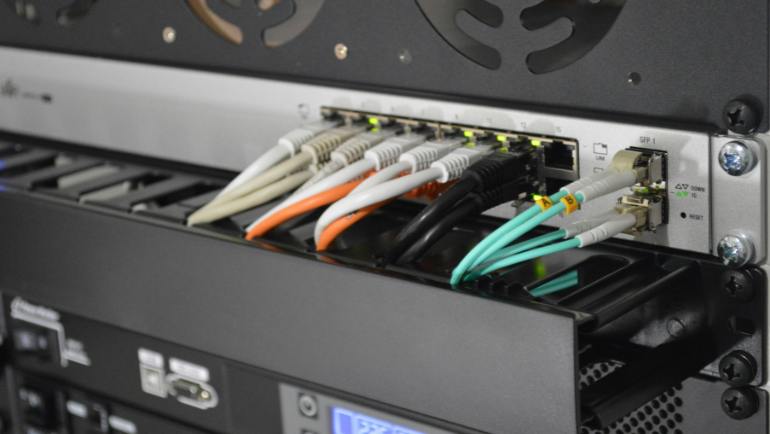
Non-volatile memory (NAND) is a type of storage technology that does not need the power to retain data. All NAND flash memory saves data in blocks and relies on electric circuits to store data. Many storage devices like USB or Solid State Drives (SSDs) use this technology to provide faster more reliable performance than magnetic storage like Hard Disk Drives (HDDs).
Let’s look into different types of NAND flash memory in detail to understand each type’s importance in the ever-growing digital world.
Understanding the Types of NAND Flash Memory?
Each type of NAND flash memory is named after the number of bits used per flash media cell, making it much easier to understand. The following section will look deeper into the various storage devices of NAND flash, highlighting their pros, and drawbacks applications.
Raw NAND

| Feature | SLC | MLC | TLC | 3D NAND |
| Structure | 1 bit per cell | 2 bit per cell | 3 bit per cell | Multilayer cells stacked vertically |
| Density | Low | Medium | High | High |
| Endurance | High | Medium | Low | High |
| Performance | Fast | Moderate | Slower | Improve version of MLC TLC cells |
| Life | 60,000 to 100,000 Program/Erase (P/E) life cycles | 10,000 (P/E) life cycles | 3,000 (P/E) life cycles | Varies with different cell types |
| Cost | Most expensive | Moderate expensive | Affordable | Varies with type of performance |
| Recommended use | High-end applications for industries | consumer-based applications for enterprise storage | consumer-based applications for general purpose | consumer-based applications with high storage needs |
Single-Level Cell (SLC)
Single Level Cell (SLC), as the name suggests stores one bit of information per flash cell, allowing faster processing speed. The SLC life cycle ranges from 60,000 to 100,000, higher than many NAND flash memory other cells.
Advantages:
- Low chance of Error
- Highest Endurance among other NAND Types
- Longest read-write cycles or P/E cycle
Drawbacks:
- Most expensive in all other NAND types
- Limited availability
- Not available in 3D NAND
Recommended Use
- Best for commercial industrial applications due to its reliability
- Commonly used for heavy read-write cycles
Multi-Level Cell (MLC)
A type of NAND flash memory can store 2 bits of data in one cell, having a balanced combination of price, and performance durability. Also, MLC read write life cycles are around 10,000 per cell, significantly lower than SLC.
Advantages
- Higher bit rate than SLC
- Less expensive than SLC
Drawbacks
- Lower number of write cycles
- More chances of error
- Less durable than SLC
Recommended Use
- Mostly used in consumer-based electronics like laptops or PCs
Embedded MLC (eMLC)
To rectify the lower reliability and durability of MLC NAND, flash manufacturers have created an enhanced MLC flash cell, called eMLC. It accommodates more read/write cycles than consumer-based MLC around 20,000 to 30,000 per cell. Better voltage margin, and slower erase cycle enhance its life reliability in enterprise operation, that’s why it’s also known as enterprise MLC.
Triple Level Cell (TLC)
Another type of NAND flash memory suited for consumer-based products is capable of storing 3 bits of data per cell. Compared to other NAND types they have higher storage density, but offer poor reliability and performance endurance. However, this extra storage comes with a lower endurance of around 3000 P/E cycles.
Advantages
- Lower cost compared to other NAND types
- Available in both 2D and 3D NAND types
Drawbacks
- Fewer P/E cycles than other types
- Lower lifespan
Recommended Use
- Best for general consumer use, and not ideal for industrial applications
- Some 3D NAND TLC variants show potential in tackling enterprises’ workloads
Quad-Level Cell (QLC)
The next step in NAND flash technology is the creation of QLC, which further increases the storage capacity but with lower endurance. QLC NAND flash memory stores 4 bits of data per cell, which is particularly used in read-intensive applications like AI or machine learning.
Advantages
- The most cost-effective among NAND-type
- 3D QLC can offer up to 1000 P/E cycles from the standard 300 P/E cycles
Drawbacks
- Fewer P/E cycles than other NAND type
- Bad for write-intensive operation
Recommended Use
- Best for write-based enterprise workloads like big data, analytics and more
Managed NAND

| Feature | e.MMC | e.MCP | uMCP | eUSB | UFS |
| Package | Single package | Multi-chip package | Unified multi-chip package | External | Integrated circuit |
| Components | NAND flash memory | NAND flash memory, RAM | NAND flash memory, RAM | NAND flash memory | NAND flash memory, RAM, controller |
| Performance | Moderate | Moderate to high | High | Moderate | High |
| Space Efficiency | Moderate | Moderate to high | High | High | High |
| Integration | Limited | Partial | Full | External | Full integration |
| Recommended use | Low-end devices | Mid-range devices | High-end devices | External storage like USB | High-performance devices |
e.MMC Memory
e.MMC is also referred to as embedded Multi Media Card and used as primary storage in portable devices such as cell phones. These flash memories are permanently embedded in the system board as a single integrated circuit (IC). The latest eMMc specification has a transfer rate of up to 400 MBps comparable to SSDs using a SATA connection.
Advantages
- Ruggedized to stand up to environmental stress
- eMMC connected to the main circuit board reduces the load on the device’s CPU processor, making operation faster
- Lower power consumption than spinning disk storage
Drawbacks
- Special purpose eMMC may come with a higher price tag
- Short lifespan
- Not readily upgradable like other storage devices
Recommended Use
- It is mostly used in the mobile industry and some lightweight notebook computers
eMCP
The eMCP storage sits between eMMC UFS storage solutions, providing moderate performance in electronic devices. eMCP stands for Embedded MultiChip Packages and consists of NAND, IC DRAM.
Advantages
- Consume less power
- Provide lower latency
- Devices with eMCP chips have smaller motherboards
Drawbacks
- Lower performance than dedicated storage devices
- Limited flexibility
Recommended Use
- Ideal for small-size electronic devices or IOT applications
uMCP
Unified Multi-Chip Package in which multiple components like RAM, and storage are embedded into a single package. This optimizes the space and performance of many electronic devices.
Advantages
- Allows a more compact design
- Improves system performance
Drawbacks
- Limited upgradability due to embedded nature
- Higher cost of repair, if damaged
Recommended Use
- Best for OEM or ODM manufacturers and mobile devices
Embedded USB Storage
In flash storage devices, embedded USB or eUSB is popular in industrial applications as it offers a high endurance capacity of 32GB. USB is perfect for loading an OS and logging critical data while providing ease of integration and mechanical ruggedness.
Advantages
- Provides high-speed data transfer
- Power efficient compared to USB flash drives
- Supports a wide range of devices such as keyboard, mouse more.
Drawbacks
- No security protection, anyone can use it
- You can not upgrade without an adapter
- Susceptible to physical or environmental damage
Recommended Use
- Best for consumer base electronics, PCs, IoT applications and more
Universal Flash Storage (UFS)
A type of non-volatile memory that is extensively used in electronic devices, digital cameras. UFS is created to increase the speed of microSDs but in the same form factor design. The average microSD speed varies from 25MB/s to 156 MB/s in full-duplex mode, while UFS offers speeds up to 530 MB/s.
Advantages
- High performance
- Low power consumption
Drawbacks
- Expensive than other microSD
- More vulnerable to data corruption loss than HDDs or SSDs
Recommended Use
- Ideal for application that requires higher performance with lower power consumption in a small form factor
3D NAND/ V-NAND
In 3D NAND or V-NAND, the cells are stacked vertically in multi-layers compared to 2D NAND which has one layer of cells placed horizontally. This increases the data density, allowing higher storage capacity without increasing the cost. It comes in all interfaces such as NVMe, SATA and SAS. 3D NAND technology is available in MLC, QLC and TLC NAND but not SLC.
Advantages
- They have better endurance in other NAND types except for SLC
- Lower power consumption
- Higher writer performance
Drawbacks
- The price of 3D NAND fluctuates due to extra manufacturing cost
Recommended Use
- Best for demanding tasks such as running multiple virtual machines or running scientific calculations
Best NAND Flash Memories

All aforementioned NAND flash memories have their unique functions. Before buying computer memory, always make careful consideration of what type of form factors to choose and which interface such as NVMe or SATA aligns with your requirements. To help you in your decision-making process, Compting Worlds offers some NAND flash memories for sale at the best prices.
You can require a free bulk quote for the required number of drives.
Frequently Ask Questions
How to Erase NAND Flash Memory?
You can erase NAND flash memory, either manually or by using a software program.
Is SSD NAND Flash Memory the Same?
No, SSD is one of the many types of NAND flash memory including microSD, UFS more.
Who Invented NAND Flash?
Fujio Masuoka invented NAND flash technology in 1987.
NAND flash memories have revolutionized the world of storage devices by providing faster, more reliable storage solutions. A range of options from consumer-based to enterprise-grade applications in various price ranges. Different NAND devices use AES encryption to protect your data such as Opal 2.0 SED. Moreover, enterprises also opt for encrypted motherboards TPM 1.2 and TPM 2.0 for an extra layer of security. Understanding different types of flash memory and its recommended use will help you optimize your workflow.
You can also combine DRAM and NAND memories together to boost system performance or use RAID technology to combine SSD drives for shared speed and storage. This is why it’s important to know important facts about SSDs before purchasing storage solutions for your enterprise.
For more information, stay connected with the Computing Worlds blog.






